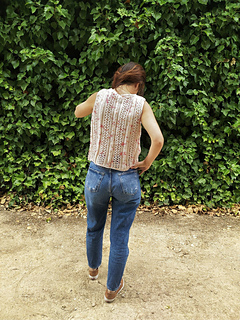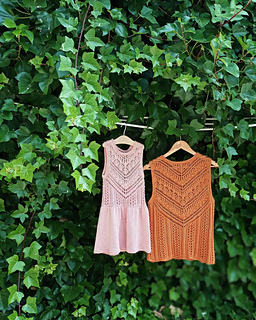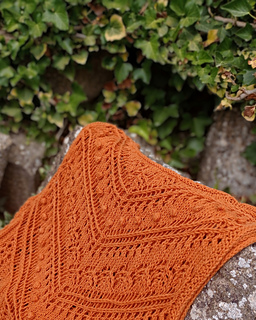patterns >  Esti Juango's Ravelry Store
Esti Juango's Ravelry Store
> Uda tee

























Uda tee
Lacework tee to challenge and inspire you. Part of Mini&Me collection. Pattern also available for children.
Spanish below/español abajo
Inspiration
When we play with lacework, we create textures reminiscent of lace from other eras. Summer allows dresses to be worn with lacework creating unique and timeless garments that stand out in your closet.
Difficulty Level
Intermediate/ Advanced
Pattern has been tech edited and tested
What do you need to know?
To knit and purl, increase and decrease on right side and wrong side. The top pattern is charted only. I include a video to help you with charts if it is your first time. To work in the round for the neckline. Support videos available for some stitches.
Sizes
1 (2, 3, 4, 5) with final measurement of the tee after blocking of 91 (100, 109, 118, 126) cm / 35.75 (39.25, 43, 46.5, 49.5) in.
Materials
- Yarn: Katia Missouri– 50gr; 145m (153yds). 60% Cotton, 40% Acrylic
- Amount: 4 (4, 4, 4, 5) skeins of 50 gr. Total in m: 580 (580, 580, 580, 725) m Total in yds: 612 (612, 612, 612, 765) yds
- Other yarn suggestions provided
- 4 mm (US 6) needles
- 3,5 mm (US 4) for neckline
- 3,5mm and 4 mm (US 6) circular needles with 60/80 cm cable for working the neckline and the skirt in the round
- 4 mm (G-6) crochet hook for the bobbles
- Markers
- Waste yarn or stitch holders
- Tapestry needle
Gauge
In a 10x10 cm (4x4 in) square you should have 20 sts and 26 rows worked in lace pattern. Gauge is worked flat. Block the gauge before measuring it.
Construction notes
The top is knitted flat. First the back and then the front. The shoulder seams are joined and the neckline is knitted. The side seams are joined and the armhole edges are knitted.
Pattern can be easily adapted to work in the round up to the armholes. Work the front and back chart at the same time.
Patrón para inspirarte y desafiarte. Parte de la colección Mini&Me con patrón adaptado para las peques de la casa.
Inspiración
Cuando jugamos con los calados, creamos texturas que recuerdan a puntillas de otras épocas. El verano permite que los vestidos puedan lucir con calados creando prendas únicas y atemporales que destaquen en los armarios y cada verano descubramos con ilusión.
Nivel de Dificultad
Intermedio/ Avanzado
El patrón ha sido editado y testeado
Requisitos previos
Saber tejer derecho, revés, hacer aumentos y disminuciones por el lado derecho y revés de la labor. Tejer en circular para acabados de cuello y sisa. Se incluye un esquema completo del top por tallas. Hay una descripción detallada de cada punto. Se incluyen videos de apoyo para varios puntos y para cómo leer los gráficos.
Tallas
1 (2, 3, 4, 5) con contorno de pecho en prenda desde 91 cm a 126 cm.
Materiales
- Lana: Katia Missouri– 50gr; 145m (153yds). 60% Algodón, 40% Acrílico Cantidad: 4 (4, 4, 4, 5) ovillos de 50 gr Total en m: 580 (580, 580, 580, 725) m
- Sugerencias otras lanas
- Agujas de 4 mm para el top
- Agujas de 3,5 mm para el cuello
- Agujas circulares de 3,5 mm y 4 mm con cable de 60/80 cm para el cuello y la falda respectivamente
- Ganchillo de 4 mm para los bodoques
- Marcadores
- Imperdible o hilo adicional para dejar p en espera
- Aguja lanera para coser los laterales
Tejido de Muestra
En un cuadrado tejido en plano de 10 x 10 cm con el punto calado obtendrás 20p por 26 Pas con una aguja de 4 mm. Bloquea la muestra para poder medirla. Teje una muestra de unos 15 x 15 cm, para poder contar bien la muestra en el centro.
Notas de construcción
El top se teje en plano, por un lado el delantero y luego el trasero. Una vez tejidos, se unen las costuras del cuello y se teje la terminación del cuello y de las mangas. Se une las costuras de los laterales y se termina el top.
Aunque está descrito para tejer en plano, se puede tejer en circular hasta la sisa, tejiendo a la vez el esquema del trasero y delantero, leyéndolo siempre por el LD.
207 projects
stashed
156 times
- First published: September 2022
- Page created: August 22, 2022
- Last updated: March 23, 2025 …
- visits in the last 24 hours
- visitors right now






